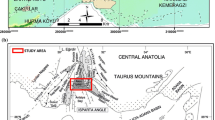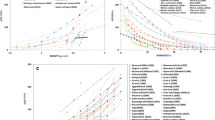Abstract
The purpose of this study was to investigate the effect of apparent porosity on the engineering properties of volcanic rocks. Therefore, 22 volcanic rocks collected from the Eastern Black Sea Region of Turkey were sampled and tested in the current study. Laboratory experiments involved the tests for uniaxial compressive strength (UCS), point load index (Is(50)), P wave velocity (V p ), apparent porosity (n a (percent)), and dry unit weight (γ dry) of the rock samples. The same core sample for each rock type was used in these tests. The tested rocks with n a < 1 % generally exhibited high fluctuations in the UCS values ranging from 89 to 202 MPa. Hence, the correlation between UCS and Is(50) was evaluated for both n a > 1 % and n a < 1 %. Additionally, the n a values were correlated with the UCS, Is(50), UCS/Is(50), γ dry, V pdry, and V psat. values in case of the n a > 1 % and n a < 1 %. The experimental data showed that the apparent porosity values significantly affected the engineering properties (UCS, Is(50), γdry, and V p ) of the rock samples tested. Generally, a satisfactory correlation among the engineering properties of the rocks was obtained only for n a > 1 %. Only a weak correlation (R 2 = 0.4) was present between the V pdry and n a for the rock samples having n a < 1 %.









Similar content being viewed by others
References
Azadan P, Ahangari K (2013) Evaluation of the new dynamic needle penetrometer in estimating uniaxial compressive strength of weak rocks. Arab J Geosci. doi:10.1007/s12517-013-0921-6
Broch E, Franklin JA (1972) The point-load strength test. Int J Rock Mech Min Sci Geomech Abstr 9(6):669–676
Diamantis K, Gartzos E, Migiros G (2009) Study on uniaxial compressive strength, point load strength index, dynamic and physical properties of serpentinites from Central Greece: test results and empirical relations. Eng Geol 108:199–207
Ersoy H, Kanik D (2012) Multicriteria decision-making analysis based methodology for predicting carbonate rocks' uniaxial compressive strength. Earth Sci Res J 16(1):65–74
Fener M, Kahraman S, Bilgil A, Gunaydin O (2005) A comparative evaluation of indirect methods to estimate the compressive strength of rocks. Rock Mech Rock Eng 38(4):329–343
Gaviglio P (1989) Longitudinal waves propagation in a limestone: the relationship between velocity and density. Rock Mech Rock Eng 22:299–306
Heidari M, Khanlari GR, Kaveh MT, Kargarian S (2012) Predicting the uniaxial compressive and tensile strengths of gypsum rock by point load testing. Rock Mech Rock Eng 45:265–273
Irfan TY, Dearman WR (1978) The engineering petrography of weathered granite in Cornwall. England. Quarterly Journal of Engineering Geology II: 233–244
ISRM (1979) Suggested Methods for determining the uniaxial compressive strength and deformability of rock materials, commission on standardization of laboratory and field tests. Int J Rock Mech Min Sci Geomech Abstr 16:135–140
ISRM (1981a) ISRM Suggested Mehods. In: Brown ET (ed) Suggested Methods for determining sound velocity. Pergamon Press, Oxford, pp 107–110
ISRM (1981b) In: Brown ET (ed) Suggested method for determining water content, porosity, density, absorption and related properties, swelling and slake-durability index properties. Pergamon Press, Oxford, pp 81–94
ISRM (1985) Point load test, suggested method for determining point load strength. Int J Rock Mech Min Sci Geomech Abstr 22:55–60
Kahraman S (2001) Evaluation of simple methods for assessing the uniaxial compressive strength of rock. Int J Rock Mech Min Sci 38:981–994
Kahraman S, Gunaydin O, Fener M (2005) The effect of porosity on the relation between uniaxial compressive strength and point load index. Int J Rock Mech Min Sci 42:584–589
Karaman K, Cihangir F, Ercikdi B, Kesimal A (2010) The Effect of specimen length on ultrasonic p-wave velocity in clayey-carbonate rocks (in Turkish). Madencilik Dergisi 49(4):37–45
Khandelwal M, Singh T (2011) Predicting elastic properties of schistose rocks from unconfined strength using intelligent approach. Arab J Geosci 4:435–442
Kılıç A, Teymen A (2008) Determination of mechanical properties of rocks using simple methods. Bull Eng Geol Environ 67:237–244
Lama RD, Vutukuri VS (1978) Handbook on mechanical properties of rocks. Vol. 2. Trans Tech. Publications, Clausthal, Germany
Minaeian B, Ahangari K (2013) Estimation of uniaxial compressive strength based on P-wave and Schmidt hammer rebound using statistical method. Arab J Geosci 6:1925–1931
Mishra DA, Basu A (2012) Use of the block punch test to predict the compressive and tensile strengths of rocks. Int J Rock Mech Min Sci 51:119–127
Moh’d BK (2009) Compressive strength of vuggy oolitic limestones as a function of their porosity and sound propagation. Jordan J Earth Environ Sci 2(1):18–25
Ozcelik Y, Bayram F, Yasitli NE (2013) Prediction of engineering properties of rocks from microscopic data. Arab J Geosci 6:3651–3668
Palchik V, Hatzor YH (2004) The influence of porosity on tensile and compressive strength of porous chalks. Rock Mech Rock Eng 37(4):331–341
Quane SL, Russel JK (2003) Rock strength as a metric of welding intensity in pyroclastic deposits. Eur J Mineral 15:855–864
Sabatakakis N, Tsiambaos G, Gerochristodoulou D (2002) Estimation of physical and mechanical parameters of rock material. Bulletin of the Public Works Central Laboratory of Greece (KEDE), Special Edition, Athens, pp. 3–8
Shalabi FI, Cording EJ, Al-Hattamleh OH (2007) Estimation of rock engineering properties using hardness tests. Eng Geol 90:138–147
Sharma PK, Singh TN (2007) A correlation between P-wave velocity, impact strength index, slake durability index and uniaxial compressive strength. Bull Eng Geol Environ 67:17–22
Singh TN, Kainthola A, Venkatesh A (2012) Correlation between point load index and uniaxial compressive strength for different rock types. Rock Mech Rock Eng 45(2):259–264
Singh TN, Pradhan SP, Vishal V (2013) Stability of slopes in a fire-prone mine in Jharia Coalfield, India. Arab J Geosci 6:419–427
Torabi SR, Shirazi H, Hajali H, Monjezi M (2013) Study of the influence of geotechnical parameters on the TBM performance in Tehran–Shomal highway project using ANN and SPSS. Arab J Geosci 6:1215–1227
Tsiambaos G, Sabatakakis N (2004) Considerations on strength of intact sedimentary rocks. Eng Geol 72:261–273
Tugrul A (2004) The effect of weathering on pore geometry and compressive strength of selected rock types from Turkey. Eng Geol 75:215–227
Tugrul A, Zarif IH (1999) Correlation of mineralogical and textural characteristics with engineering properties of selected granitic rocks from Turkey. Eng Geol 51:303–317
Ulusay R, Türeli K, Ider MH (1994) Prediction of engineering properties of a selected litharenite sandstone from its petrographic characteristics using correlation and multivariate statistical techniques. Eng Geol 37:135–157
Vasconcelos G, Lourenço PB, Alves CAS, Pamplona J (2008) Ultrasonic evaluation of the physical and mechanical properties of granites. Ultrasonics 48:453–466
Yagiz S (2011) P-wave velocity test for assessment of geotechnical properties of some rock materials. Bull Mater Sci 34:947–953
Yasar E, Erdogan Y (2004) Correlating sound velocity with density, compressive strength and Young modulus of carbonate rocks. Int J Rock Mech Min Sci 41(5):871–875
Acknowledgments
The authors are deeply grateful to Karadeniz Technical University Research Fund for the financial support and Prof. Dr. Hacı Deveci for improving the quality of the paper.
Author information
Authors and Affiliations
Corresponding author
Rights and permissions
About this article
Cite this article
Karaman, K., Kesimal, A. Evaluation of the influence of porosity on the engineering properties of volcanic rocks from the Eastern Black Sea Region: NE Turkey. Arab J Geosci 8, 557–564 (2015). https://doi.org/10.1007/s12517-013-1217-6
Received:
Accepted:
Published:
Issue Date:
DOI: https://doi.org/10.1007/s12517-013-1217-6




